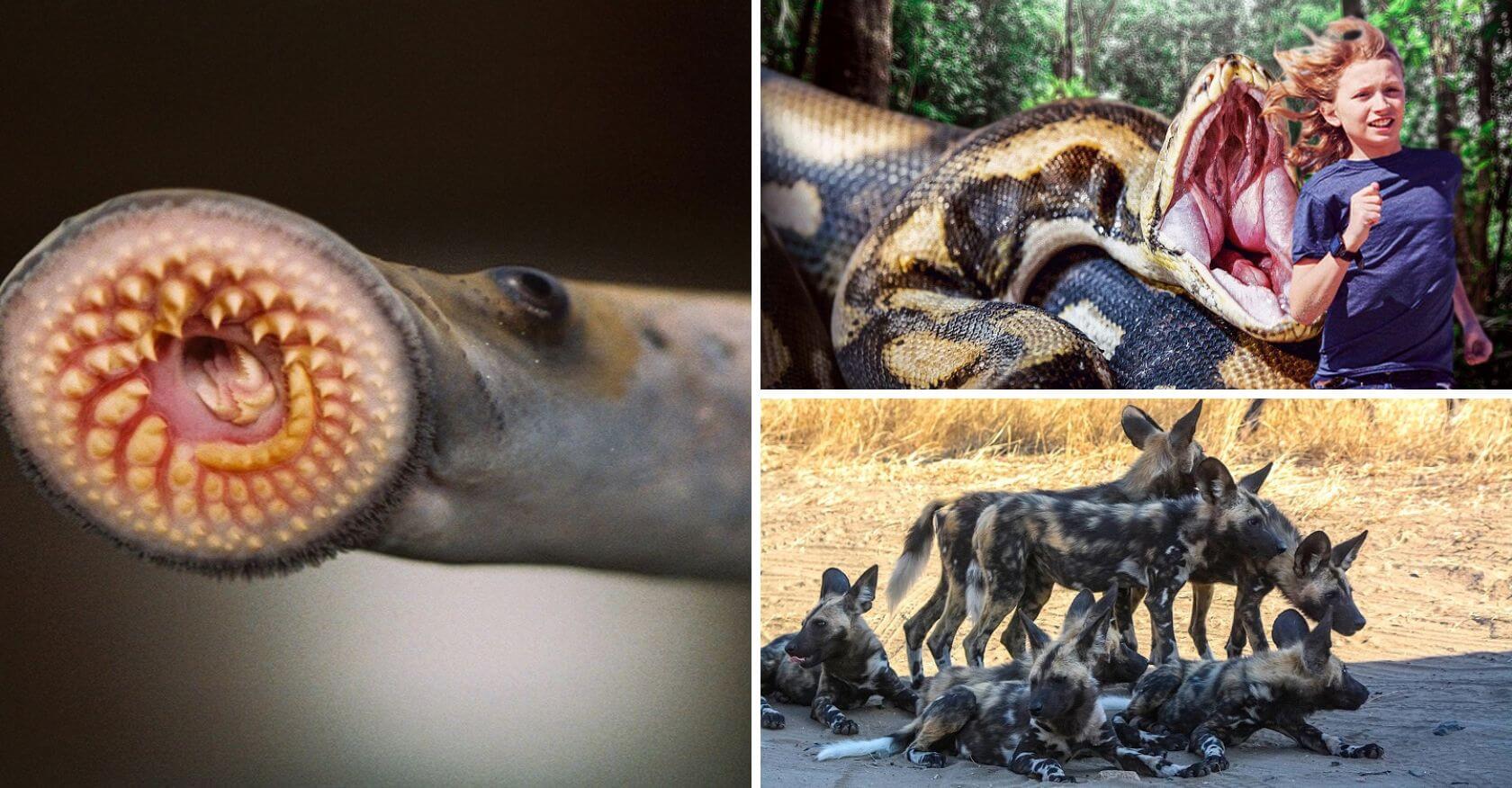Animal Facts
The animal kingdom is home to some amazing traits. Cheetahs can run at 70 mph (112 kph) [source: Enoch]. Camels can survive half a year without a water source [source: California Academy of Sciences]. Frogs can freeze in winter and then thaw, alive, in spring [source: Roach].
As far as superlative animal talents go, these are just a few of the better known. There are plenty that haven't become common knowledge yet, and some of them are exceptionally gross, frightening, awkward, or seemingly impossible. Some are so anthropomorphic you have to laugh.
Here, we've collected 10 of those crazy facts, and we bet even animal-trivia buffs will be surprised by at least a few. You may laugh, you may deny. You'll almost certainly say "awww" more than you'd like. You may even squirm: We human types can be a little squeamish when it comes to, say, a penis with four heads.
And that's only the beginning of that one.
10: An Echidna Has a Four-headed Penis

Odd penises aren't unique in the animal world – and to the animals sporting them, of course, they're not odd at all. Snakes have two half-penises that join when it's time to mate [source: Medical Dictionary]. Sea-slug penises are disposable [source: Kaplan]. Cat penises are barbed [source: Dell'Amore].
But the echidna, often called a "spiny anteater," tops them all. The Australia-area native sports a single shaft with four heads, each one capable of ejaculation. Only two of the heads function at any given time, though, which makes sense since the female echidna has "only" two vaginas. During copulation, one side of the penis is inactive, its two heads retracted, while the other side is ready to fertilize the female's eggs. After ejaculation, the male echidna activates the other side and repeats the process [source: Cooke].
No one is entirely sure why there are so many darned heads, but experts hypothesize it has something to do with mating competition. Female echidnas might have sex with 10 or more males at mating time, so having four ejaculation sources probably increases the odds of any one echidna passing along his genes [source: Cooke].
9: Hens Can Spontaneously Become Roosters

Spontaneous sex changes are rare in the animal world, but they do happen. Clownfish, for example (yes, Nemo) change from male to female as part of the standard mating process. But the hen situation is different: Her sex change is not beneficial to the species [source: Melina].
It starts with hen anatomy. A female chicken has one ovary and one inactive gonad, a remnant of early chicken development when sex genes haven't yet activated. A gonad can become an ovary, a testicle, or a combination of the two (ovotestis), but once those genes go the female route, that other gonad just sits there [source: Melina].
Now enter a cyst or tumor that damages the hen's ovary, and the gonad steps up to fill the sex-anatomy void. A gonad that develops into a testicle or an ovotestis instead of an ovary will start the release of androgens, a male sex hormone, and a sex change can result [source: Melina].
The typical hen-to-rooster transition begins with an end to egg-laying and progresses to behaviors and physical traits. A hen will start strutting and crowing, gain weight and grow the quintessential rooster wattles, dark feathers and cockscomb atop its head [source: Melina].
The result is essentially a sterile rooster. As far as the experts know, this change only happens to females; a rooster-to-hen conversion has never been documented [source: Melina].
8: Raccoons May Wash Food Before Eating

If your trash cans are regularly raided by these urban scavengers, you probably find this crazy fact especially hard to believe. But raccoons, at least those living in captivity, do wash their food every chance they get – though probably to a different end than when we do [source: Welshans].
With access to a water source, a raccoon will practice a dunking ritual that removes a lot of the filth from their meal. Holding, say, a half-eaten apple in its dexterous front paws, it will repeatedly and vigorously dunk it in the water, rotating the apple as it does so, before dining [source: Welshans].
This likely doesn't mean what we think it does, though. Yes, they are cleaning their food, but that might just be a side effect of the action. Researchers have found that raccoons will "dunk" their food in the air, too, if there's no water around. Why dunk at all, then, if cleanliness isn't the goal? No one is sure, but it's possible it intensifies the tactile aspects of a meal. Raccoons have especially sensitive fingers, and they may just enjoy the feeling of the ritual [source: Welshans].
7: A Bald Eagle Nest Can Weigh 2 Tons

The U.S. national bird, known for its dramatic wingspan of up to 8 feet (2.4 meters) has another superlative ability: nest building [source: San Diego Zoo].
Bald eagles, like most other birds, build their nests in trees. Unlike most other birds, bald eagles build nests that can break those trees.
A typical bald eagle nest is big: up to 5 feet (1.5 meters) in diameter and up to 6 feet (1.8 meters) deep. But that's nothing compared to the largest nest ever discovered. One found in Florida in the 1960s had a weight of more than 2.2 tons (2 metric tons), a diameter of 9.6 feet (2.9 meters), and a depth of 20 feet (6 meters) [source: Guinness World Records]. Another that fell out of a tree in Ohio in the 1920s was 8.5 feet (2.6 meters) across, 12 feet (3.6 meters) deep, and weighed about 2 tons (1.8 metric tons) [source: Ohio Dept. of Natural Resources].
How does a pair of birds build a nest that massive? Slowly. Bald eagles use the same nest year after year, sometimes for decades, and they're constantly adding twigs, branches, moss, feathers and other nesting material [source: San Diego Zoo]. The Ohio Department of Natural Resources estimates that bald eagles, likely more than one mating pair over time, had been building and living in that 2-ton Ohio nest for about 35 years before it fell [source: Ohio Dept. of Natural Resources].
6: A Fruit Fly's Sperm Is Much Longer Than a Man's

The longest sperm in nature lives in the body of a fruit fly. And we're not talking about proportional size. The sperm of a Drosophila bifurca fruit fly is hands-down the longest of any animal, including humans.
The Drosophila bifurca fly, roughly 3 millimeters (0.11 inch) long, produces sperm measuring about 58 millimeters, or 2.2 inches, long [source: BBC, Leary]. The sperm is tightly coiled and scrunched up in the fly's tiny body. It's so big, it doesn't swim and has to be pushed up to the storage organs by the female's reproductive tract [source: LaFlamme].
The sperm of a human, on the other hand, is about 0.06 millimeters long, or 0.002 inch, less than 1/1000th the length of the Drosophila bifurca sperm [source: 3D Science].
Humans actually have one of the shortest sperm in the animal kingdom, which fits nicely with scientists' hypothesis for the fruit fly's monster ones: The level of "sperm competition" in a species corresponds with the species' sperm length [source: LaFlamme]. In humans, sperm competition is low. In fruit flies, the female stores the sperm from her multiple suitors until it's time to fertilize the egg; in this scenario, the sperm that can barrel through the previously stored sperm has the best chance of being first in line [source: LaFlamme].
So it's a case of size versus quantity. A Drosophila bifurca produces only 100 sperm in its lifetime [source: LaFlamme]. A single human ejaculate contains about 280 million [source: Lindemann].
5. Leeches Have 300 Teeth

With its boneless, wormy form, the leech appears to have no hard components at all, let alone a mouth full of teeth. So, are you surprised to learn it has three sets of teeth? In fact, leeches have a total of 300 tiny, razor-sharp, highly effective cutting instruments in those three sets [source: Šepitka]. Without all those teeth, leeches wouldn't be doing much bloodsucking at all.
Their method is almost surgical, which perhaps is why leeches are making a comeback in modern medicine; leeches are increasingly popular tools used in establishing blood flow to re-attached body parts [source: Lubrano]. When placed on someone's skin, the leech grabs on with its "mouth," which contains three separate jaws with 100 teeth each. Then, each of the jaws and teeth makes a separate incision, forming a cut (rather like a Mercedes-Benz symbol) that initiates blood flow, and the bloodsucking begins [source: Šepitka]. In between the teeth, there are ducts that release an anticoagulant to keep the blood flowing quickly [source: Šepitka].
Luckily for patients receiving leech treatment, those ducts also discharge an anesthetic, so the process doesn't hurt much [sources: Šepitka, Lubrano]. Unluckily for those patients, those ducts don't release anything for the eww factor.
4: Butterflies Taste With Their Feet

Yes, we really mean that. Butterflies have receptors on their legs that are similar to those in the taste buds of the human mouth, only 200 times stronger [source: Encyclopedia Britannica, Clare]. In butterflies, these receptors are used primarily to test potential egg-laying sites for toxins or other detriments that could harm their offspring [source: Encyclopedia Britannica].
Full-grown butterflies don't eat -- they only drink -- but their caterpillars eat constantly [source: San Diego Zoo]. Once the eggs hatch, they start feeding on the leaves under which they were born. Since some plants produce toxins as a defense mechanism, choosing the wrong leaves can prove catastrophic [sources: San Diego Zoo, UC Irvine]. That's where mommy's feet come in.
When a female butterfly lands on a leaf, she tastes it to determine whether it's safe for her babies. If her feet detect nothing awry, she knows she can safely raise her caterpillars there.
3: A Green Anaconda Can Swallow a Man

Few people choose to get up close and personal with anacondas. The green anaconda is the heaviest snake in the world, topping out around 30 feet (9 meters) long, 1 foot (0.3 meter) in diameter, and 550 pounds (250 kilograms) [source: National Geographic].
But green anacondas rarely attack humans, and there are no confirmed cases of a human being eaten by the snake, perhaps due to the rarity of their presence in the snakes' habitat [source: Zoo Atlanta]. They live mostly in the secluded waters of South American rainforests [source: National Geographic].
Still, they could eat a human, considering their typical prey. Smaller meals include fish and wild pigs, but adult white-tailed deer, caimans and the occasional jaguar are on the menu, too. Caimans, which are similar to alligators, can reach 15 feet (4.5 meters) long [source: A-Z Animals]. Jaguars can weigh 350 pounds (159 kilograms) [source: A-Z Animals]. White-tailed deer top out around 7 to 8 feet (2.1-2.4 meters) and weigh up to 300 pounds (136 kilograms) [source: National Geographic]. Compare that to the average man with a height of 5 feet 9 inches (1.7 meters) and a weight of 195 pounds (88 kilograms) [source: Statistic Brain].
To swallow larger animals, the snake coils around the prey's body to crush and/or asphyxiate it. Then the snake slowly works the animal down its gullet, head first. It widens its jaws, which are attached by stretchy ligaments before it grabs the prey with its teeth, After a large meal, an anaconda may not dine for months [sources: National Geographic, Rivas].
But not all large prey agrees with them; an anaconda throwing up an entire cow was captured on video.
2: Dachshunds Are More Aggressive Than Pit Bulls

Common sense says pit bulls are aggressive by nature. Pit bull attacks against humans make the news for their often tragic results.
Turns out, pit bulls are some of the nicer dogs out there. They can't help it if their jaws are ridiculously strong.
A 2008 study conducted at the University of Pennsylvania analyzing thousands of dogs from 33 breeds found that pit bulls were easily topped by none other than wiener dogs -- er, dachshunds -- in terms of bite attacks against people. Of the dachshunds in the study, 20 percent had bitten or attempted to bite strangers, and 6 percent had bitten or attempted to bite their owners, compared to 7 percent and 2 percent, respectively, of the pit bulls. Chihuahuas, Jack Russells and beagles also beat out pit bulls for aggression toward people [source: Duffy, Hsu and Serpell].
Pit bulls did score high in aggressiveness toward other dogs; dachshunds did, too. But combined aggression toward humans and dogs earned wiener dogs the top spot for overall aggression [source: Dobson].
1: African Wild Dogs Care for Their Elderly

Few animals are anthropomorphized like dogs. Humans may attribute traits like empathy, guilt, and even altruism to their canine friends, often with the sneaking suspicion that it's mostly the bacon smell driving things.
A quick look at the behavior of African wild dogs, however, might challenge the bacon theory. These members of the Canidae family, which also includes our domestic canine buddies, practice some decidedly humane behaviors, including caring for the elderly, ill or otherwise fragile members of their pack [source: National Geographic]
African wild dogs, native to sub-Saharan Africa, live in packs that function as families. Pack members stay together for their entire lives, and no dog gets left behind – or goes hungry [source: Wildlife Conservation Society]. In stark contrast to most other carnivores, when the pack makes a kill, every dog gets to eat, even those who couldn't contribute to the effort [source: Wildlife Conservation Society].
After a meal, young, healthy dogs will return to the den and seek out ill, very old or very young pack members and feed them by regurgitating some of the kill [source: Wildlife Conservation Society]. It's like meals on wheels.
And if this makes you think about taking better care of your grandparents right now, you're not alone.
Lots More Information
Author's Note: 10 Crazy Facts You Didn't Know About Animals
I seldom pitch article ideas, but I made an exception here. The idea came from watching one of my daughter's favorite TV shows, a nature-education program called "Zaboomafoo" hosted by the Kratt Brothers, from which both of us have gathered some amazing knowledge. Early on, I learned that kangaroos use their tails as kind of a third leg when hopping slowly, which for some reason fascinated me, and each time I've shared the knowledge with friends I've gotten the same response: I didn't know that! So I decided to go deeper and learn some other facts. I left out my daughter's enthusiastic recommendations because I thought my readers might already know them, but in case you're interested: Gazelles run really fast; cheetahs eat gazelles; and lions eat zebras. (I'm guessing we'd watched a predator episode that day.)






